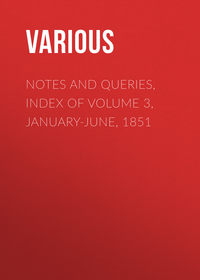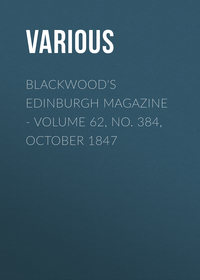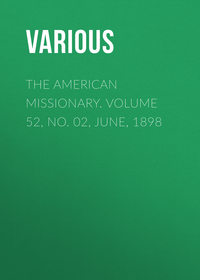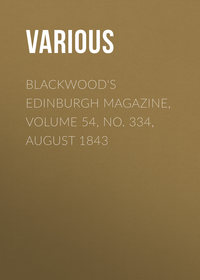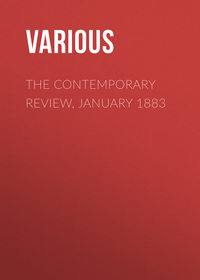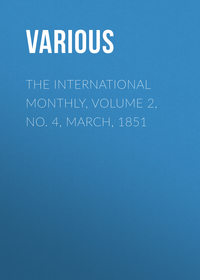 полная версия
полная версияAppletons' Popular Science Monthly, March 1899
Of the two principal physical types to-day comprised within the limits of the Ural-Altaic languages, the Turks and Tatars seem to be affiliated with the Mongol rather than the Finn, not physically alone, but in respect of language as well. As a matter of fact, they are racially nearer the Aryan-speaking Europeans than most people imagine, in everything except their speech. Their nearest relatives in Asia seem to be the Turkoman peoples, who, to the number of a million or more, inhabit the deserts and steppes of western Asia. It was from somewhere about this latter region, as we know, that the hordes of the Huns under Attila, and those of Genghis Khan and Tamerlane, set forth to the devastation of Europe. The physical type of these inhabitants of Turkestan has been fairly well established by anthropologists. It persists throughout a great multitude of tribes of various names, among whom the Kara-Kirghez, Uzbegs, and Kiptchaks are prominent.22 On page 625 we have portraits of these Turkoman types. The most noticeable feature of the portraits is the absence of purely Mongol facial characteristics. Except in the Kara-Kirghez the features are distinctly European. There is no squint-eye; the nose is well formed; the cheek bones are not prominent, although the faces are broad; and, most important of all, the beard is abundantly developed, both in the Uzbeg and the Kiptchak. The Kara-Kirghez, on the other hand, betrays unmistakably his Mongol derivation in every one of these important respects. One common trait is possessed by all three – to wit, extreme brachycephaly, with an index ranging from 85 to 89. The flatness of the occiput is very noticeable in our portraits in every case, giving what Hamy calls a "cuboid aspect" to the skull. These portraits, if typical, should be enough to convince us that the Turkoman of the steppes about the Aral and Caspian Seas is far from being a pure Mongol even in his native land, although a strain of Mongol blood is apparent in many of their tribes.
The fact is that the Asiatic Turkomans, whence our Osmanli Turks are derived, are a highly composite type. A very important element in their composition is that of certain brachycephalic peoples of the Pamir, the Galchas and mountain Tadjiks. These are for all practical purposes identical with the Alpine type of western Europe. In their accentuated brachycephaly, their European facial features, their abundance of wavy hair and beard, and finally in their intermediate color of hair and eyes,23 these latter peoples in the Pamir resemble their European prototypes, or perhaps we had better say, congeners. So close is this affiliation that the occurrence of this type in western Asia is the keystone in any argument for the Asiatic origin of the Alpine race of Europe. The significance of it for us in this connection is that it explains the European affinity of many of the Turkoman tribes, who are more strongly European than Mongol in their resemblances. It is highly important, we affirm, to fix this in mind, for the prevalent opinion seems to be that the Turks in Europe have departed widely from their ancestral Asiatic type, because of their present lack of Mongol characteristics, such as almond eyes, lank black hair, flat noses, and high cheek bones.
Either the Osmanli Turks were never Mongols, or they have lost every trace of it by intermixture. Our portraits on the opposite page give little indication of Asiatic derivation except in their accentuated short-and broad-headedness. This is considerably more noticeable in Asia Minor than in European Turkey.24 West of the Bosporus the Turks differ but little from the surrounding Slavs in head form. They have been bred down from their former extreme brachycephaly, which still rules to a greater degree in Asia Minor. In our portraits from this region the absence of occipital prominence is very marked. In addition to this, the Turks are everywhere, as Chantre observes, "incontestably brunet." The hair is generally stiff and straight. The beard is full. This latter trait is fatal to any assumption of a persistence of Kirghez blood, or of any Mongolic extraction, in fact. The nose is broad, but straight in profile. The eyes are perfectly normal, the oblique Mongol type no more frequent than elsewhere. In stature tallness is the rule, judging by Chantre's data, but in this respect social conditions are undoubtedly of great effect. On the whole, then, we may consider that the Turks have done fairly well in the preservation of their primitive characteristics. Chantre especially finds them quite homogeneous, considering all the circumstances. They vary according to the people among whom their lot is cast. Among the Armenians they become broader-headed, while among the Iranian peoples – Kurds or Persians – the opposite influence of intermixture at once is apparent.
The Bulgarians are of interest because of their traditional Finnic origin and subsequent Europeanization. This has ensued through conversion to Christianity and the adoption of a Slavic speech. Our earliest mention of these Bulgars would seem to locate them between the Ural Mountains and the Volga.25 The district was, in fact, known as Old Bulgaria till the Russians took it in the fifteenth century. As to which of the many existing tribes of the Volga Finns represent the ancestors of these Bulgarians, no one is, I think, competent to speak. Pruner Bey seems to think they were the Ostiaks and Voguls, since emigrated across the Urals into Asia; the still older view of Edwards and Klaproth made them Huns; Obédénare, according to Virchow, said they were Samoyeds or Tungus; while Howorth and Beddoe claim the honor for the Chuvashes. These citations are enough to prove that nobody knows very much about it in detail. All that can be affirmed is that a tribe of Finnic-speaking people crossed the Danube toward the end of the seventh century and possessed themselves of territory near its mouth. Remaining heathen for two hundred odd years, they finally adopted Christianity and under their great leaders, Simeon and Samuel, became during the tenth century a power in the land. Their rulers, styling themselves "Emperors of the Slavs," fought the Germans; conquered the Magyars as well as their neighbors in Thrace, receiving tribute from Byzantium; became allies of Charlemagne; and then subsided under the rule of the Turks. Since the practical demise of this latter power they have again taken courage, and in their semi-political independence in Bulgaria and northern Roumelia rejoice in an ever-rich and growing literature and sense of nationality.
Bulgarian is spoken, as our map at page 614 indicates, far outside the present political limits of the principality – indeed, over about two thirds of European Turkey. Gopčević has made a brilliant attempt to prove that Macedonia, shown by our map and commonly believed to be at bottom Bulgarian, is in reality populated mainly by Serbs.26 The weakness of this contention was speedily laid bare by his critics. Political motives, especially the ardent desire of the Servians to make good a title to Macedonia before the disruption of the Ottoman Empire, can scarcely be denied. Servia needs an outlet on the Mediterranean too obviously to cloak such an attempted ethnic usurpation. As a fact, Macedonia, even before the late Greco-Turkish war, was in a sad state of anarchy. The purest Bulgarian is certainly spoken in the Rhodope Mountains; there are many Roumanians of Latin speech; the Greeks predominate all along the sea and throughout the three-toed peninsula of Salonica, while the Turks are sparsely disseminated everywhere. And as for religion – well, besides the severally orthodox Greeks and Turks, there are in addition the Moslem and apostate Bulgarians, known as Pomaks, who have nothing in common with their Greek Catholic fellow-Bulgars, together with the scattering Pindus Roumanians and Albanians in addition. This interesting field of ethnographic investigation is, even at this late day, practically unworked. As Dr. Beddoe writes – and his remarks are equally applicable to Americans – "here are fine opportunities for any enterprising Englishman with money and a taste for travel and with sufficient brains to be able to pick up a language. But, alas! such men usually seem to care for nothing but 'killing something.'"
The Roumanians, or Moldo-Wallachians, are not confined within the limits of that country alone. Their language and nationality cover not only the plains along the Danube and the Black Sea, but their speech extends beyond the Carpathian Mountains over the entire southeastern quarter of Hungary and up into the Bukovina. Transylvania is merely a German and Magyar islet in the vast extent of the Roumanian nation. There are more than a third as many Roumanians as there are Magyars in the Hungarian kingdom, according to the census of 1890. Politically it thus happens that these people are pretty well split up in their allegiance. Nor can this condition be other than permanent. For the Carpathian Mountains, in their great circle about the Hungarian basin, cut directly through the middle of the nation as measured by language. This curious circumstance can be accounted for only on the supposition that the disorder in the direction of the Balkan Peninsula, incident upon the Turkish invasion, forced the growing nation to expand toward the northwest, even over the natural barrier interposed between Roumania proper and Hungary. Geographical law, more powerful than human will, ordains that this latter natural area of characterization – the great plain basin of Hungary – should be the seat of a single political unit. There is no resource but that the Roumanians should in Hungary accept the division from their fellows over the mountains as final for all political purposes.27
The native name of these people is Vlach, Wallach, or Wallachian. Various origins for the name have been assigned. Lejean asserts that it designates a nomad shepherd, in distinction from a tiller of the soil or a dweller in towns. Picot voices the native view as to ethnic origins by deriving the word Wallach from the same root as Wales, Walloon, etc., applied by the Slavs and Germans to the Celtic peoples as "foreigners." This theory is now generally discountenanced. Obédénare's attempt to prove such a Celtic relationship has met with little favor.28 The western name Roumanian springs from a similarly exploded hypothesis concerning the Latin origin of these people. To be sure, Roumanian is distinctly allied to the other Romance languages in structure. It is an anomaly in the eastern Slavic half of Europe. The most plausible explanation for this phenomenon, and one long accepted, was that the modern Roumanians were descendants of the two hundred and forty thousand colonists whom the Emperor Trajan is said to have sent into the conquered province of Dacia. The earlier inhabitants of the territory were believed to have been the original Thracians. Since no two were agreed as to what the Thracians were like, this did not amount to much. Modern common sense has finally prevailed over attempts to display philological erudition in such matters. Freeman expresses this clearly. Roumania, as he says, lay directly in the pathway of all invasions from the East; the hold of the Romans upon Dacia was never firm; the province was the first to break away from the empire; and finally proof of a Latinization only at the late date of the thirteenth century is not wanting. The truth seems to be that two forces were contending for the control of eastern Europe. The Latin could prevail only in those regions which were beyond the potent influence of Greece. Dacia being remote and barbarian, this Latin element had a fighting chance for survival, and succeeded.
Our ethnic map at page 614 shows a curious islet of Roumanian language in the heart of the Greek-speaking territory of Thessaly. There is little sympathy between the two peoples, according to Hellène. The occurrence of this Roumanian colony, so far removed from its base, has long puzzled ethnographers. Some believe the peoples were separately Romanized in situ; others that they were colonists from Dacia in the ninth and tenth centuries. At all events, these Pindus Roumanians are too numerous – over a million souls – to be neglected in any theory as to the origin of their language.29 Another islet of quasi-Roumanian speech occurs in Istria, on the Adriatic coast. Its origin is equally obscure.30
It is no contradiction that, in spite of the fact of our exclusion of Roumania from the Balkan Peninsula owing to its Latin affinities, thereby seeming to differentiate it sharply from Bulgaria, the latter of Finnic origin; that we now proceed to treat of the physical characteristics of the two nationalities, Roumanian and Bulgarian, together. Here is another example of the superficiality of language, of social and political institutions. They do not concern the fundamental physical facts of race in the least. At the same time we again emphasize the necessity of a powerful corrective, based upon purely natural phenomena, for the tendency of philologists and ethnographers to follow their pet theories far afield, giving precedence to analogies of language and customs over all the potent facts of geographical probability. Let us look at it in this light. Is there any chance that, on the opposite sides of the Danube, a few Finns and a few Romans respectively interposed among the dense population which so fertile an area must have possessed, even at an early time, could be in any wise competent to make different types of the two? There is nothing in our confessedly scanty anthropological data to show it, at all events. We must treat the lower Danubian plain as a unit, irrespective of the bounds of language, religion, or nationality.
It was long believed that the Bulgarians were distinctive among the other peoples of eastern Europe by reason of their long-headedness. All the investigations upon limited series of crania pointed in that direction. This naturally was interpreted as a confirmation of the historic data as to a Finnic Bulgarian origin very distinct from that of the broad-headed Slavs. Several recent discoveries have put a new face upon the matter. In the first place, researches by Dr. Bassanovitch, of Varna, upon several thousand recruits from western Bulgaria prove that in the west these Bulgarians even outdo many of the Balkan Slavs in their broad-headedness.31 At the same time it appears that the older authorities were right, after all, in respect of the eastern Bulgarians. Among them, and also over in eastern Roumelia, long heads are still the rule. The oval-faced Bulgarians among our portraits are probably of this dolichocephalic type. Their contrast facially with the broad-headed Roumanians is very marked. Thus it is established that the Bulgarian nation is by no means a unit in its head form. We should add also that, although not definitely proved as yet, it is highly probable that similar variations occur in Roumania. In the Bukovina brachycephaly certainly prevails. Our square-faced Roumanians on page 621 may presumably be taken to represent this type. This broad-headedness decreases apparently toward the east as we leave the Carpathian Mountains, until along the Black Sea it seems, as in Bulgaria, to give way to a real dolichocephaly.32
How are we to account for the occurrence of so extended an area of long-headedness all over the great lower Danubian plain? Our study of the northern Slavs has shown that no such phenomenon occurs there among the Russians. It certainly finds no counterpart among the southern Slavs or the Turks. The only other people who resemble these Bulgars in long-headedness are the Greeks. Even they are far separated; and, in any event, but very impure representatives of the type. What shall we say? Two explanations seem to be possible, as Dr. Beddoe observes.33 Either this dolichocephaly is due to the Finnicism of the original Bulgars, or else it represents a characteristic of the pre-Bulgarian population of the Danube basin. He inclines with moderation to the former view. The other horn of the dilemma is chosen by Anutchin34 in a brilliant paper at the late Anthropological Congress at Moscow. According to his view – and we assent most heartily to it – this dolichocephaly along the Black Sea represents the last survival of a most persistent trait of the primitive inhabitants of eastern Europe. Referring again to our study of Russia,35 we would call attention to the occurrence of a similar long-headed race underlying all the modern Slavic population. We are able to prove also that such a primitive substratum occurs over nearly all Europe. It has been unearthed not far from here, for example, at Glasinac in Bosnia. When archæological research is extended farther to the east, new light upon this point may be expected. It will be asked at once why this primitive population should still lie bare upon the surface, here along the lower Danube, when it has been submerged everywhere else in Central Europe. Our answer is ready. Here in this rich alluvial plain population might, expectedly, be dense at a very early period. As we have observed before, such a population, if solidly massed, opposes an enormous resistance to absorption by new-comers. A few thousand Bulgarian invaders would be a mere drop in the bucket of such an aggregation of men. We are strengthened in this hypothesis that the dolichocephaly of the Danubian plain is primitive, by reason of another significant fact brought out by Bassanovitch.36 Long-headedness is overwhelmingly more prevalent among women than among men. The former represent more often what Bassanovitch calls the "dolichocephalic Thracian type." The oval-faced Bulgarian woman among our portraits would seem to be one of these. Now, in our treatment of the Jews,37 we have sought to illustrate the principle that in any population the primitive type persists more often in the women. The bearing of such a law in the case of the Bulgars would seem to be definite. Their long-headedness, where it occurs, must date from a far more remote period than the historic advent of the few thousand immigrants who have given the name Bulgaria to the country.
As for the other physical traits of the Bulgarians and Roumanians there is little to be added. It goes without saying that they are both deep brunets. Obédénare says the Roumanians are very difficult to distinguish from the modern Spaniards and Italians. This is probably true in respect of brunetness. The Oriental cast of features of our portraits, on the other hand, can not fail to attract attention. More than two thirds of Bassanovitch's nineteen hundred and fifty-five Bulgarians were very dark-haired. Light eyes were of course more frequent, nearly forty per cent being classed as blue or greenish. A few – about five per cent – were yellow or tawny-haired, these individuals being at the same time blue-eyed. This was probably Procopius's excuse for the assertion that the Bulgars were of fair complexion. He also affirmed that they were of goodly stature. This is not true of either the modern Roumanians or Bulgars. They average less than five feet five inches in height,38 being considerably shorter than the Turks, and positively diminutive beside the Bosnians and other southern Slavs. The Bulgarians especially are correspondingly stocky, heavily boned and built. We may also affirm a real difference in temperament between the two nationalities, built up, as we assert, from the same foundation. The Wallachians are said to be more emotional and responsive; the Bulgarians inclined to heaviness and stolidity. Both are pre-eminently industrious and contented cultivators of the soil, with little aptitude for commerce, so it is said. We hesitate to pass judgment upon either in respect of their further aptitudes until fuller data can be provided than are available at the present time.
MARVELOUS INCREASE IN PRODUCTION OF GOLD
By ALEXANDER E. OUTERBRIDGE, JrThe increasing annual production of gold in the world is a matter of such far-reaching economic importance, not only in the financial affairs of nations, but also in their industrial progress and in their civilization, that a vast amount of patient study has been given by eminent statisticians to the subject, and much time expended in compiling, from various historical records and other sources of information, statistical data which can be confidently accepted as approximately correct, showing the annual production of the precious metal from the time of the discovery of America down to the present day.
A publication of the United States Treasury Department, issued in 1897, containing information respecting the production of precious metals, etc., gives statistical tables showing the annual production of gold in the world, commencing with the year 1493. The earlier records are taken from a table of averages for certain periods compiled by Dr. Adolph Soetbeer, and the later figures (from 1885 to 1896) are the annual estimates of the Bureau of the Mint. Other tables show the annual production of gold from the mines of the United States alone from 1845 to 1896, and it is from these official sources mainly that the information has been gathered for this article, supplemented, however, by a full and very interesting communication to the author from the Director of the Mint, giving the latest figures, not yet published, and containing the estimates and deductions of the director respecting the production of gold in the world in 1898. This information is so timely and valuable that the author is of the opinion that the courteous letter of the Director of the Mint in response to his inquiries, if appended to this article, may prove to be – like the postscript of a lady's correspondence – its most important feature.
Students of political economy are well aware of the fact that some theorists have maintained that the annual production of gold in the world (apart from the phenomenal discoveries in California about the middle of the century, which were of an ephemeral character) does not keep pace with the natural increase in trade requirements, if gold is to maintain its position as the standard measure of value and the universal medium of exchange. This theory, after having passed through the various stages of pro and con argument in academic theses, became the "war cry" of a political party in this country composed of heterogeneous elements in the community, all inspired with one common idea that the balance of power in commercial transactions had been destroyed by the overwhelming force of concentration of capital and the "cornering" of the visible supply of gold in the world by a few enormously wealthy bankers. It was shown that, while the average annual production of gold in the world in five years from 1855 to 1860 exceeded $134,000,000, there was a constant decline thereafter, so that the annual average during five years from 1881 to 1885 barely exceeded $99,000,000, according to official estimates; also that the annual gold product of the mines of the United States declined from a value of $65,000,000 in 1853 to $33,000,000 in 1892. Furthermore, although a rising tendency was observed in each subsequent year, the production from the mines of this country in 1894 was still under $40,000,000, as was shown by the statistics of the United States Treasury Department.
While admitting the general accuracy of these statements of fact, it is the purpose of this paper to endeavor to show that the conclusions drawn therefrom were entirely fallacious, because due cognizance was not taken of the wonderful progress that has been made in recent years in mining and metallurgical arts whereby countless millions of tons of ore containing gold in such a finely divided state, or in such a refractory condition, that it was formerly worthless (costing more to recover the gold than the value of the precious metal contained in the ore), have now rendered these low-grade ores the most stable sources of supply of gold. Metallurgists, having knowledge of these facts, have at various times during the past ten years predicted that a golden stream would soon begin to flow from these practically new and apparently inexhaustible sources; but the people at large were wholly incredulous, and they are now astounded at the magnitude of the production of gold in the world in the past two years; and more especially, perhaps, are they amazed at the increase of production in the United States, as shown by the official reports of the Director of the Mint.
The gold production of the world in 1897 amounted in value, according to the most reliable estimates, to more than $237,000,000, and in 1898 to more than $280,000,000; and it is the opinion of the Director of the Mint that the final compilation of figures will show that the production was "somewhere between $290,000,000 and $300,000,000!"





